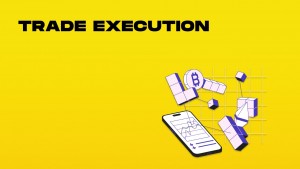What Is Trade Execution?
Trade execution is the process of filling an order to buy or sell securities in the securities markets. It’s the moment your intention to trade becomes an actual transaction.
But here’s what you might not realize: how your order gets executed can be as important as what you’re trading.
The Trade Execution Process
Step 1: Order Placement
You submit an order through your broker’s platform specifying:
-
The security you want to trade
-
Whether you’re buying or selling
-
The quantity
-
The order type (market, limit, etc.)
Many investors using online brokerage accounts assume they have a direct and instantaneous connection to the securities markets, but this is not always the case.
Step 2: Order Routing
Your broker sends your order to a venue for execution. Brokers must evaluate various competing markets to determine the best venue for executing your order. This could be:
-
An exchange (NYSE, NASDAQ)
-
An alternative trading system (ATS)
-
A market maker or dealer
-
An internalization pool (where brokers match orders internally)
The routing decision isn’t random—brokers often have predetermined relationships with certain venues, sometimes receiving payment for order flow.
Step 3: Order Execution
Once your order reaches the venue, it gets matched with a counterparty. In fast-moving markets, the additional time required to achieve price improvement may result in a worse price than the current market quote:
-
Market orders execute immediately at current market prices
-
Limit orders execute only at your specified price or better
-
Stop orders become market orders once a trigger price is reached
Step 4: Confirmation and Settlement
After execution, you receive confirmation, and the settlement process begins (typically T+2, meaning the transaction settles two business days after execution).
Brokers are required to disclose the market centers to which they route a significant percentage of their orders, enhancing transparency for customers.
Types of Trade Orders
| Order Type | How It Works | Best Used When |
|---|---|---|
| Market Order | Executes immediately at current market price | You prioritize speed over price |
| Limit Order | Executes only at specified price or better | You want price control |
| Stop Order | Becomes a market order when the stop price is reached | You want to limit losses or protect gains |
| Stop-Limit Order | Becomes a limit order when the stop price is reached | You want to limit losses but with price control |
Why Execution Quality Matters
Poor execution can cost you money in several ways:
Regulatory requirements mandate that market centers trading national market system securities provide comprehensive disclosures about order execution and routing practices.
Price Improvement
The difference between the execution price and the quoted price when you placed the order. When a broker gets you a better price than what was quoted, that’s positive price improvement. Price quotes are tied to specific numbers of shares, which means investors might not receive the exact prices they see due to market fluctuations.
Speed of Execution
Delays can mean price changes before your order fills—particularly important in fast-moving markets. In a fast-moving market, the time taken for order execution may impact the price received.
Liquidity
For large orders or thinly-traded securities, finding enough buyers or sellers without moving the market price can be challenging.
Execution quality disclosures on a stock-by-stock basis help investors understand the execution of their orders relative to public quotes.
Hidden Costs
Beyond commissions, execution quality impacts your total cost. A broker with zero commissions but poor execution may cost more than one charging fees but delivering better execution. Check your account agreement for information on your broker's policies related to order execution and payment for order flow.
How to Evaluate Your Broker's Execution and Payment for Order Flow
Look for these metrics in your broker’s Rule 605 and 606 reports:
-
Effective/Quoted Spread: The difference between the bid and ask prices
-
Price Improvement: Percentage of orders executed at prices better than the quoted market
-
Execution Speed: Average time from order submission to execution
-
Order Routing Practices: Where your broker sends orders and any payment for order flow arrangements
Understanding how your orders are routed to a particular market center can provide insights into the execution quality you receive.
Execution Challenges in Different Market Conditions
High Volatility
When markets are swinging wildly, prices can change dramatically between when you place an order and when it executes. Market orders become particularly risky. There is often a trade-off between speed and the potential for price improvement in volatile markets.
Low Liquidity
In thinly-traded securities, large orders can cause significant price slippage—where your execution price is far from your expected price.
Market makers play a crucial role in providing liquidity for thinly-traded securities.
Market Gaps
Sometimes prices jump or fall significantly between trades, especially overnight or during market halts. Stop orders can execute at prices far from your stop price. Stop orders can execute at a worse price than expected during market gaps.
Advanced Execution Strategies
VWAP (Volume-Weighted Average Price)
Aims to execute orders close to the average price weighted by volume over a specific timeframe. Useful for large orders that could move the market.
Traders should periodically assess the effectiveness of their VWAP strategies.
TWAP (Time-Weighted Average Price)
Breaks a large order into smaller pieces executed at regular intervals, aiming to achieve an average price over time. TWAP orders are often executed using automated systems to ensure consistency and efficiency.
Implementation Shortfall
Measures the difference between the decision price (when you decided to trade) and the actual execution price, accounting for all costs.
Effective risk management is crucial for minimizing the costs associated with implementation shortfall.
The Impact of Technology on Execution
Modern crypto trading technology has transformed execution:
-
Algorithmic Trading: Computer programs executing trades based on predefined instructions
-
Smart Order Routing: Technology that finds the best venue for your order
-
Dark Pools: Private venues where large blocks can trade without revealing order information to the public market
Best Practices for Better Execution
-
Use limit orders for price control in volatile markets
-
Consider time of day (markets are typically more volatile at open and close)
-
Break large orders into smaller pieces
-
Research your broker’s execution quality using Rule 605/606 reports
-
Understand payment for order flow arrangements your broker may have. Brokers should provide clear information to customers interested in understanding where their orders were routed for execution.
Key Takeaways
Your trading results depend not just on what and when you trade, but how your trades execute. The lowest commission broker isn’t always cheapest when execution quality is considered. For active traders, poor execution can significantly erode returns over time.
By understanding the execution process and evaluating your broker’s performance, you can make more informed decisions about where and how to trade—potentially saving costs that might otherwise go unnoticed.
Remember: in trading, what happens after you click “buy” or “sell” matters just as much as the decision itself. Ensuring best execution is not just a regulatory requirement but also crucial for maintaining client trust and satisfaction.
























